Why are popcorn ceilings no longer popular? Your questions answered – and 5 modern alternatives to elevate a ceiling
Once the height of home decor trends, popcorn ceilings have since fallen out of favor, but why...
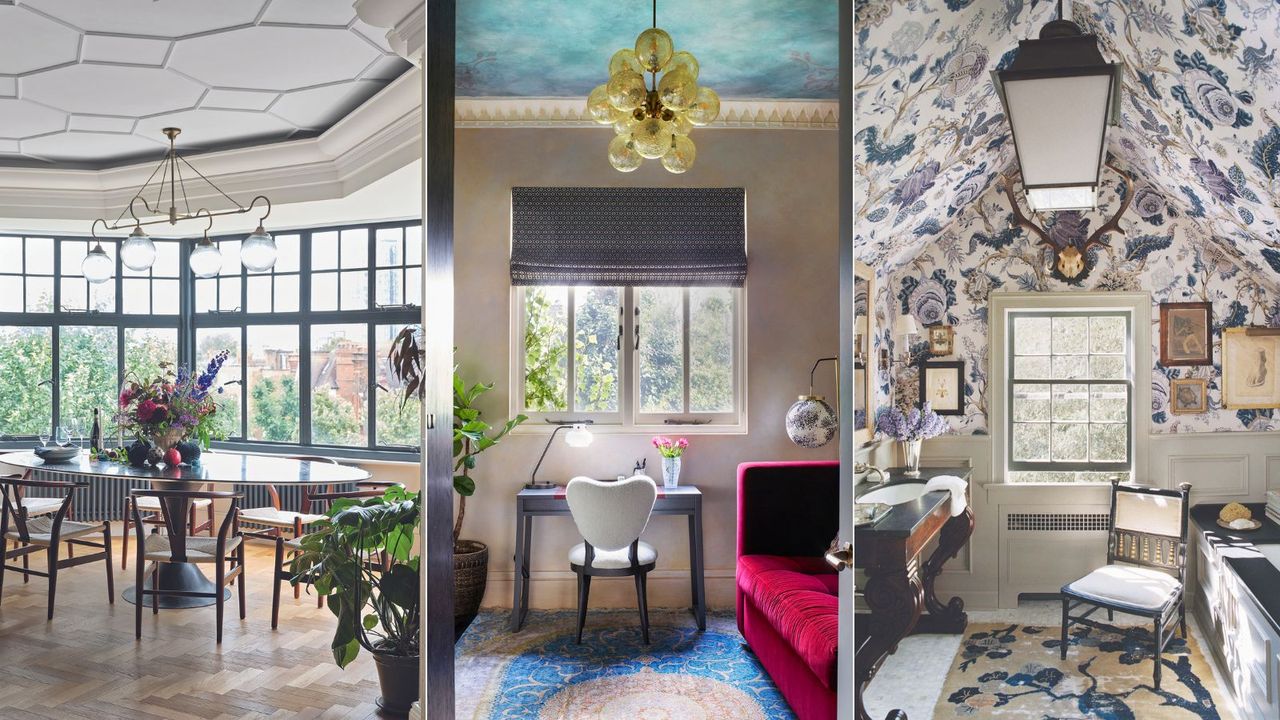

Has there ever been a design trend more universally loathed than the popcorn ceiling? They are, after all, unwanted eyesores.
Starting sometime in the mid-to-late 20th century, and blooming in popularity in the Seventies, popcorn ceilings (also called acoustic or stucco ceilings) are a type of textured ceiling style that resemble kernels of popcorn. However, like many home decorating trends from this period in time, the humble popcorn ceiling has fallen deeply out of favor, and many homeowners now want to get rid of a popcorn ceiling for good.
But before we delve deep into why popcorn ceilings are no longer popular, we must understand why they were ever popular in the first place...
When did popcorn ceilings go out of style?
If you’re renovating an older property there’s a good chance that some of the ceilings will have textured finishes. Popcorn ceilings were a popular decorative feature in the mid-20th century. The appeal was both aesthetic and practical – being a flexible finish meant it could accommodate a certain amount of movement without cracks appearing at plasterboard joints. However, the main appeal was financial: developers could get ceilings finished without the need to employ expensive plasterers.
However, it is only some years later that it was discovered that popcorn ceilings containing ACMs (asbestos-containing materials) could be harmful to human health. This naturally occurring silicate mineral was used in early formulations of the ceiling treatment until it was banned by the Clean Air Act in 1978.
Not all textured ceilings contain asbestos but until proven otherwise it’s safest to treat all such coatings with caution.
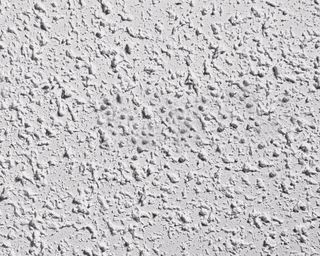
What is the point of a popcorn ceiling?
The term ‘popcorn’ ceiling is actually a generic term but has become widely used for all types of textured coatings. So a ‘popcorn ceiling’ simply means one with a highly-textured finish. This ceiling type ranges from neatly combed swirl patterns, or discreet ‘bubble wrap’ ceilings comprising hundreds of small blobs, to full-on prong-like shards.
During the era when textured ceilings were popular, many builders used them in homes because they were inexpensive and could hide imperfections with relative ease. Popcorn ceilings were made to bolster the room’s acoustics via the reduction of ambient sounds and echoes.
Do people still use popcorn ceilings?
Popcorn ceilings are never used in modern or new-build homes, and interior designers, decorators, and builders don't choose this design unless requested by a client. Whatever its original appeal, popcorn ceiling today simply isn’t a good look.
In some homes, periodic exposure to clouds of cigarette smoke or burning toast will have bestowed a nicotine-colored patina, further emphasizing the material’s deeply unappealing quirkiness.
However, while popcorn ceilings are considered an unfashionable trend now, there has been an increase in decorative ceiling ideas that make the most of this 'fifth wall'.
What can I use instead of a popcorn ceiling?
Ceilings offer scope to expand your creativity beyond your four walls. There is a multitude of ways to elevate your ceiling with materials, color, texture, and even wallpaper, and none of them need to include an outdated popcorn ceiling.
‘Ceilings have been overlooked in recent times,’ says interior designer Rachel Chudley, ‘but when you visit historic houses, the ceiling is often treated as a masterpiece.’
1. Introduce interest above with a coffered ceiling
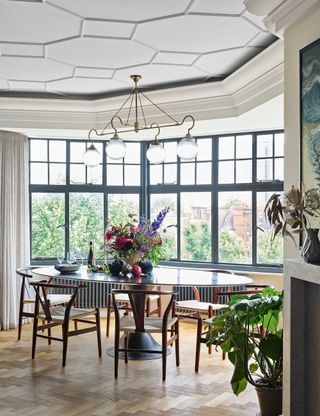
Interior designers and architects use clever ceiling tricks to add the illusion of height to a room. ‘Coffered ceilings make a room feel so much bigger. Architectural details can add real drama to a space,' says Jane Landino of design practice Taylor Howes.
‘Anything that draws your eye upwards gives the illusion of higher ceilings and grandeur. These not only add interest but also “cheat” the height of the room and make it look taller. With a coffered ceiling, we also like to use details such as concealed lighting.'
2. Draw the eye upwards with creative color choices

'The ceiling in a home office is a great way to add layering and a three-dimensional aspect to the design of a space, says Elnaz Namaki, creative director, Elnaz Namaki Studio.
For this study and occasional bedroom, interior designer Elnaz Namaki chose a completely bespoke plastered paint color solution, working with a plaster finish artisan. This was overlaid in the corners with bespoke paisley stencils around the spotlights.
3. Pay homage to architectural features

Ceilings are an opportunity to take a bold wallpaper idea and supersize it. In this case, that means straight up the wall and right across the ceiling with contrasting striped paper. To achieve this effect, it’s worth using an experienced decorator to deliver the best outcome.
An elegant look for ceiling wallpaper ideas, wallpapering the fifth wall will create a structured, timeless effect for your ceiling.
4. Paint a feature wall above
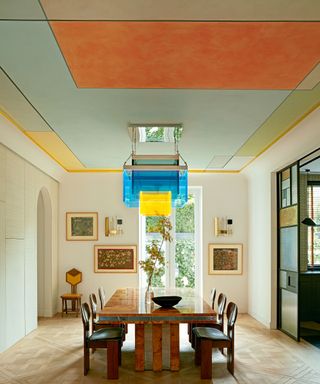
In this modern dining room, Scott Maddux of Maddux Creative has used color on the ceiling to full effect. Without its eye-catching ceiling, this dining room would be a restrained space, filled with very desirable 20th-century furniture but with no element of surprise and wonder.
When designing a room, it is crucial to take inspiration from your surroundings. Here, the client’s impressive art collection provided inspiration and specifically the work of British artist Ben Nicholson and French glass maker Louis Barillet. Scott commissioned artist Isabelle Day to carry out the painstaking paintwork.
5. Add warmth with wood

In this modern living room, designed by Turner Pocock, the use of timber on the ceiling echoes the natural matting on the floor to create a cozy and cocooning space.
Wood is having a revival in popularity thanks to our desire to embrace nature within our homes. Old or new, pale or dark, the warm and tactile nature of time ensures it enhances any home.
Sign up to the Homes & Gardens newsletter
Design expertise in your inbox – from inspiring decorating ideas and beautiful celebrity homes to practical gardening advice and shopping round-ups.

Jennifer is the Digital Editor at Homes & Gardens. Having worked in the interiors industry for several years in both the US and UK, spanning many publications, she now hones her digital prowess on the 'best interiors website' in the world. Multi-skilled, Jennifer has worked in PR and marketing and occasionally dabbles in the social media, commercial, and the e-commerce space. Over the years, she has written about every area of the home, from compiling houses designed by some of the best interior designers in the world to sourcing celebrity homes, reviewing appliances, and even writing a few news stories or two.
-
 Gwyneth Paltrow's kitchen shelving is the cleverest use of a small, shallow, awkward space I've seen – it will solve all your storage problems and look gorgeous, too
Gwyneth Paltrow's kitchen shelving is the cleverest use of a small, shallow, awkward space I've seen – it will solve all your storage problems and look gorgeous, tooGwyneth's wall shelves act as a display case for chic dishware, while making the kitchen feel even more spacious – and you can follow her example
By Hannah Ziegler Published
-
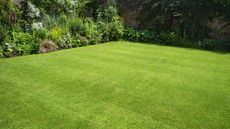 Do these 7 jobs in April to ensure a thick and green lawn all summer long, urges our resident lawn care expert
Do these 7 jobs in April to ensure a thick and green lawn all summer long, urges our resident lawn care expertTransform your lawn with these simple yet highly effective April lawn care tasks
By Drew Swainston Published